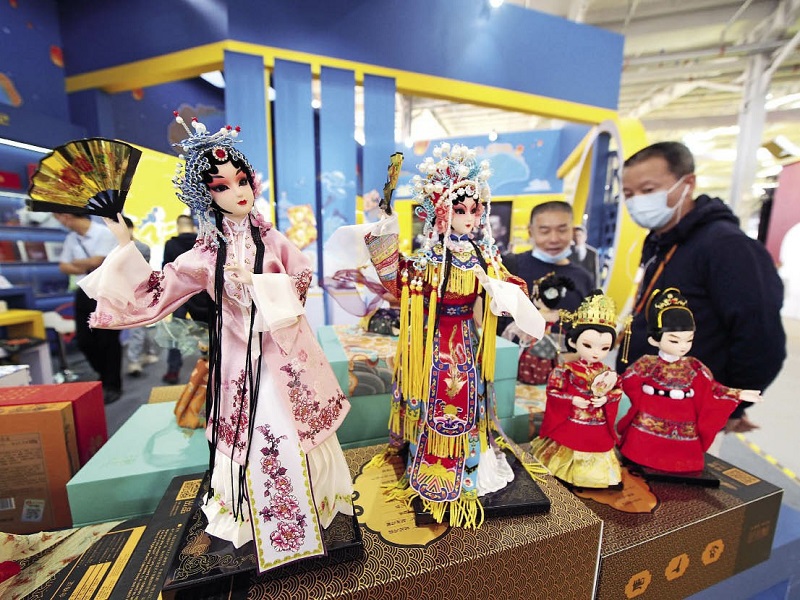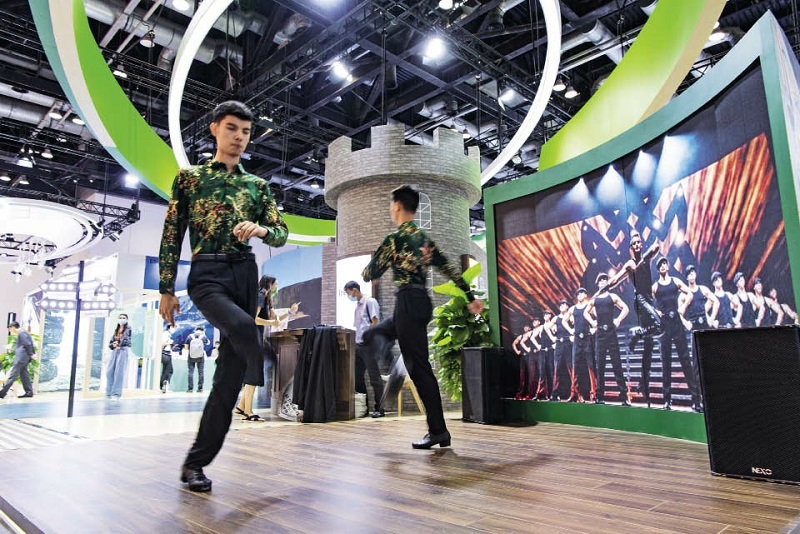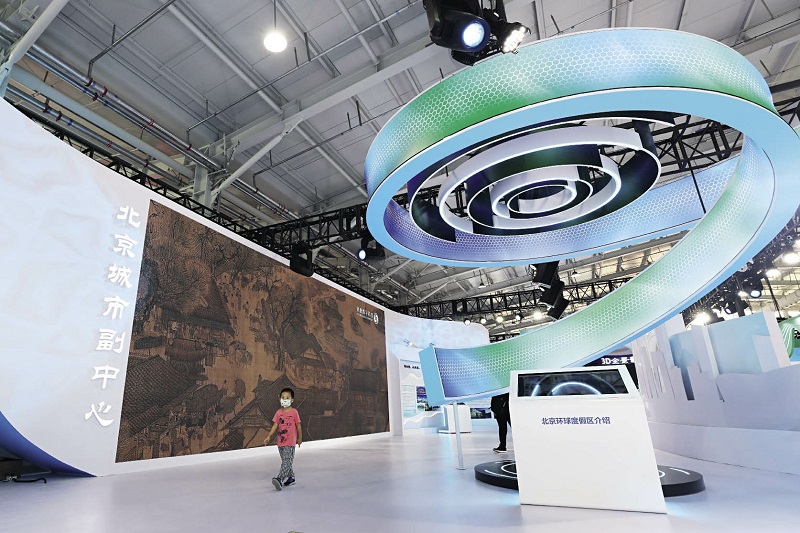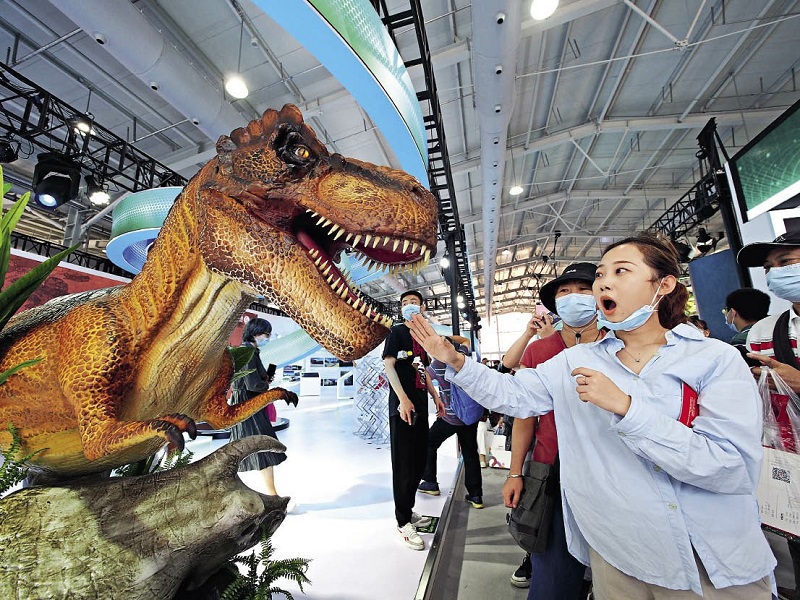
Beijing silk figurines, an intangible cultural heritage, are on display at the Culture & Tourism Service Pavilion of Shougang Park exhibition area at the 2021 CIFTIS.
This year’s China International Fair for Trade in Services (CIFTIS) not only enables professional visitors to see new kinds of advanced technology, trends, and opportunities, but also reflects interactivity and entertainment, allowing ordinary audiences to obtain a fresh and immersive experience.
Against the backdrop of the blue sky and a greenbelt, skateboarders glide down a corridor among the rusty and mottled former plants of Shougang Group, with towering chimneys and environmentally friendly modern exhibition halls standing nearby. A popular short video brought a brand-new immersive exhibition experience to the audience, and injected new life into the century-old industrial heritage of Shougang. The Shougang Park in Shijingshan District, Beijing served as one of the venues of this year’s CIFTIS. Different from previous years, this year’s fair set up dual venues for the first time, using Shougang Park as a venue for special exhibitions, which integrated modern conventions and exhibitions with industrial features and natural landscapes, giving full play to the innovative development of the CIFTIS.

The 2021 China International Fair for Trade in Services kicks off in Beijing on September 3, 2021. Ireland – the guest country of honor, invites dancers to perform traditional tap dances at its booth in the exhibition area of the China National Convention Center.
Leading New Fashions
No. 3 Blast Furnace, the landmark of the Shougang Park, was decorated with dazzling night lights at 8:00 p.m. on September 3. A national customs boutique master fashion show with the theme of “Good Time” kicked off the 2021 Beijing Consumption Season: International Fashion Festival.
The fashion show fit in well with the unique industrial features of the Shougang venue – combining industrial style and fashion elements. The famous Chinese fashion designer Fang Ying pursues a contemporary expression of local culture and art under the design concept of “inheritance and innovation.” A total of 50 sets of national style boutique women’s dresses were displayed during the activity. Whether in terms of color choice, clothing making craftsmanship or design styles, the combination of Chinese culture and modern fashion creates a new Chinese fad and inspires fashion consumerism through innovation.
The first Beijing International Consumer Center City Exhibition was held in the supply chain and commercial service exhibition area of Pavilion 12 at Shougang Park, and more than 300 new products went on exhibition for the first time. Booths of many fashion-leading companies gathered here, including SKP, one of the world’s most iconic high-end fashion department stores, Wangfujing Group with historical profundity, Sanlitun Taiguli, Beijing’s landmark of fashion trends, and Wukesong Huaxi Live, a comprehensive modern shopping mall.
From the large screen of the Sanlitun Taiguli, the open commercial block was designed with a north and south area, taking its design inspiration from the old Beijing’s Hutong and Siheyuan (quadrangle courtyard dwellings), and the incorporation of some modern elements also showcased the designer’s creativity and ingenuity. By scanning a QR code, visitors were able to obtain more detailed content and the community building report named Taiguli’s Innovation and Transformation. Some visitors admired how this not only provided domestic and foreign consumers with a diversified fashion experience, but also contributed to the construction of Beijing as an international consumption center.
“Beijing is an important window for foreigners to learn about China. The city has world-renowned cultural tourism sites and the country’s leading technological innovation advantages. Cultivating and building an international consumption city is an inevitable requirement for Beijing to integrate into the new development pattern, promote high-quality development, and better satisfy local people’s needs for a better life,” said Yan Ligang, director of the Beijing Municipal Commerce Bureau, at the 2021 Beijing International Consumption Center City Forum held on September 5.
On the same day, the first Dynamic Map of Beijing Life Service Industry Networks jointly developed by the Beijing Municipal Commerce Bureau and Meituan (China’s largest food delivery service platform) was released. According to Cai Xiaojun, deputy director of the Beijing Municipal Commerce Bureau, the dynamic map implements dynamic monitoring of the life service industry in terms of consumption, supply, and convenience; and presents the real-time information in data form, which can serve as a reference for community commercial planning management and also provide citizens with more convenient, diversified, and personalized consumer services.
“Cultivating and building international consumption center cities” has been officially included into China’s Outline of the 14th Five-Year Plan for National Economic and Social Development and the Long-Range Objectives Through the Year 2035. With the approval of the State Council on July 19, five cities including Beijing have started their efforts to build international consumption center cities. Beijing will take the lead in achieving the goal and establish a number of brands that are internationally appealing and influential so as to promote consumption upgrading towards optimal consumer engagement and experience, product sophistication and digital transformation.

Beijing’s sub-center booth highlights the culture of the Grand Canal to showcase its storied history and tourism services at the 2021 CIFTIS, on September 4, 2021.
Buying and Selling Globally
In today’s global allocation of consumption resources, buying and selling globally has gradually become a new trend. Alibaba.com set up a photo wall at its booth in the China National Convention Center to show stories of businesspeople worldwide conducting cross-border trade with China. Using their mobile phones to scan the QR code, visitors could watch video stories online.
“When purchasing medical products, Alibaba.com will always be our first choice,” said Morten Andersen, a Norwegian healthcare businessman, who purchased on the platform disposable endoscopy pants and colorful compression stockings worn by nurses. “People can quickly find the goods they need on Alibaba.com, and it is very convenient to place orders and make payments on the platform.” In his view, “Made in China” is now the guarantee of product quality. In particular, the delivery time from Shanghai is shorter than the delivery time from a city in Europe. “Here, I must thank the Chinese companies who provide us with cross-border trade services. It is really great,” Anderson said.
The Global Supply Chain Trend Development Report was released at the 2021 Global Digital Foreign Trade Supply Chain New Trend Summit Forum on September 4. According to the report, as the main platform to promote digitalization of foreign trade, Alibaba.com uses various kinds of new technology to help more than 150,000 domestic sellers effectively connect with more than 26 million active corporate buyers from more than 200 countries and regions around the world. It reduces costs, increases efficiency, and ushers global trade into a new era of inclusive trade.
At the 2020 CIFTIS, Chinese President Xi Jinping announced that the Chinese government would support Beijing to build a comprehensive demonstration zone for expanding and opening the national service industry, and establish a free trade pilot zone that features technological innovation, open service industry, and digital economy. This zone has also become the main platform for promoting the further expansion and opening up of Beijing. According to data released by the Beijing municipal government, the city’s good momentum in the use of foreign investment is highlighted by the fact that Beijing has seen the establishment of 1,035 new foreign-funded enterprises between January and July this year, which is an increase of 55.2 percent year-on-year, and the actual utilization of foreign capital is US $10.33 billion, a year-on-year growth of 19.1 percent.
Alan Beebe, president of the American Chamber of Commerce in China, has lived and worked in Beijing for 20 years and regards the capital city as his second hometown. “I am very happy to see the local government adopting new measures to attract foreign talents to work in China,” he said. “My personal experience is also sufficient to prove that Beijing has done a good job in this area, otherwise I wouldn’t be able to stay here for 20 years. I believe many foreigners share the same feelings with me.”
He further pointed out that the service industry now accounts for 80 percent of Beijing’s total economy. Foreign-invested enterprises are mainly in finance, information transmission, and software and information technology service industries. “President Xi said in a video speech that China will continue to expand its opening up, support the further development of trade in services, and help Beijing and other parts of China get better aligned with international standards. All these aspects make me happy,” he said.
In the country exhibition area at the National Convention Center, the pavilion of Ireland, the guest of honor, attracted visitors with Irish whiskey and cream liqueur, two geographical indications products mutually recognized and protected in both the Chinese and EU market, the advanced aerosol drug delivery technology, five internationally renowned universities and colleges, and the country’s business environment and industrial clusters, all on display.
Visitors could watch Argentine tango dance performances, try on traditional Korean garments for free at the Korean pavilion, learn about Austrian winter sports equipment at the Austrian pavilion, and see high-tech beauty products at the Japanese pavilion. Each country’s pavilion attracted audiences by hosting a variety of cultural activities, to help visitors understand and discuss trade cooperation matters.

Visitors interact with a model dinosaur at Beijing Tongzhou District’s booth in the Shougang Park exhibition area of the 2021 CIFTIS on September 7, 2021.
Immersive Experience
This year’s CIFTIS, in addition to showcasing new technologies, trends, and opportunities, also paid much attention to the interaction with audience to optimize their experience.
In the cultural and tourism service exhibitions, 5G, big data, AR, and VR were used as a fairly common means of displaying information. With the help of multiple scientific and technological means, visitors experienced cultural tourism in a more convenient and diverse way.
A visitor surnamed Han from Liaoning Province experienced the thrill of flying on land sitting in a simulated cockpit of Fuxing (a high-speed electric multiple unit) which was built according to the 1:1 ratio of the real model. He also took a virtual tour of the Summer Palace using a VR headset. “This kind of VR and interactive technology is amazing. The Summer Palace is immediately alive. It feels like there are really fish dodging between my feet,” Han said excitedly. “Next year I will bring my parents with me to visit the fair!”
An immersive experience is also a feature of the Beijing Sub-Center’s pavilion in the Shougang Park. Financial services and cultural and tourism services are highlights of the sub-center’s future development. At the entrance to the finance-themed area, there was a naked eye 3D LED display, which shows the past, present, and future of the Canal Financial City development. In order to attract a greater audience, three iconic scenes were presented on the 3D screen – the Canal Business District in the sub-center, Zhangjiawan Design Town, and Burning Lighthouse. When a viewer chose a photo scene, the camera would automatically capture a portrait, and merge it with the virtual scene to achieve an interactive dynamic between photography and sharing.
The pavilion of the Universal Beijing Studios theme park also used promotional videos introducing the Sub-center Cultural Tourism Zone and Universal Beijing Resort. Kung Fu Panda, Minions, Jurassic World’s dinosaur babies and other themed elements were exhibited in the booth, allowing visitors to enjoy a new experience of cultural travel in the era of digital intelligence.
Universal Beijing Resort, which officially opened on September 20, is the largest Sino-foreign cooperation project in Beijing, with a total investment of over RMB 60 billion. It is expected to bring in an annual visitor flow of 12 million people, drive more than 70 upstream and downstream sectors, directly or indirectly benefit more than 100 industries, create tens of thousands of jobs for the surrounding areas, and form a fully functional cultural and tourism industry chain.
As a spillover effect, the surrounding areas of the park will also attract and cultivate a number of cultural and technological enterprises in fields like IP design, animation and games, performing arts, and entertainment; expand a number of high-quality consumer facilities; and actively build a national demonstration zone integrating cultural, tourism, and business development.